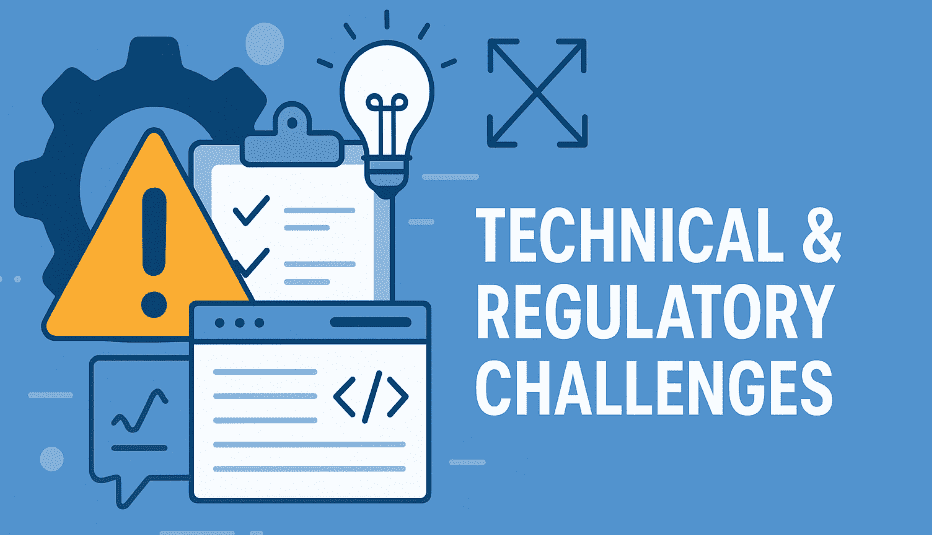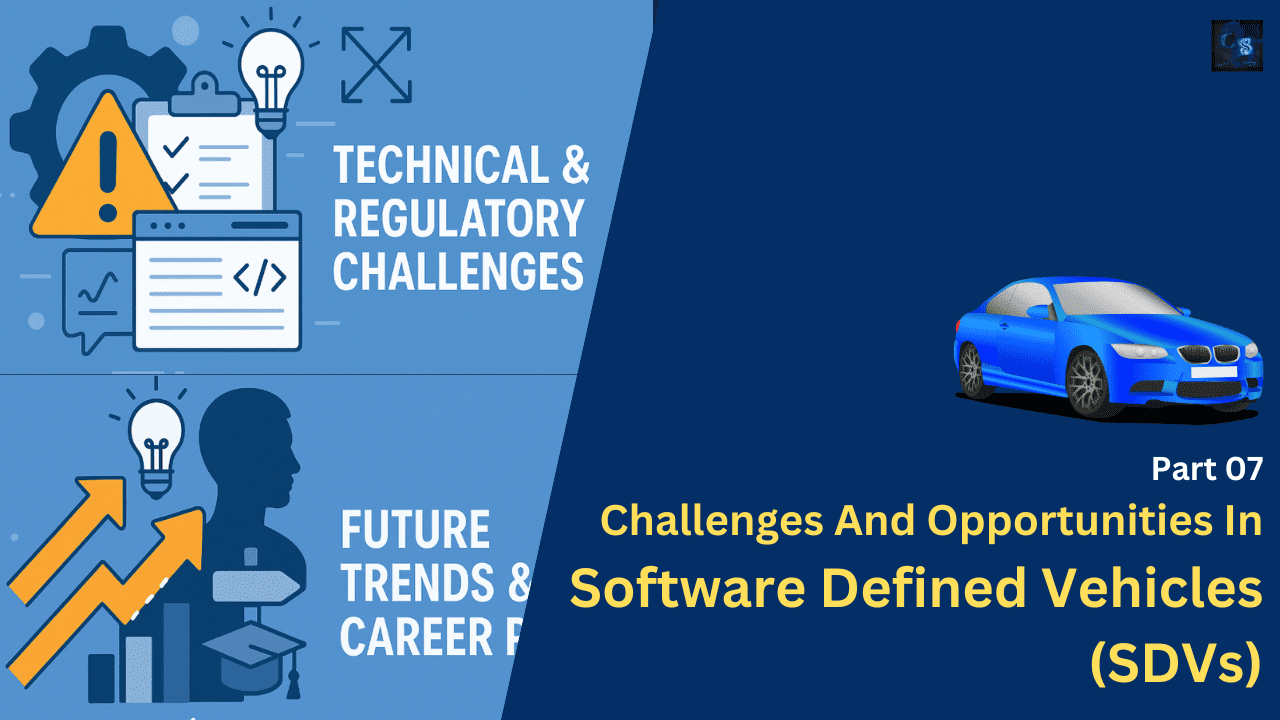Challenges And Opportunities In Software Defined Vehicles (SDVs): Part 07
Hello guys, welcome back to our blog. In this article, I will discuss challenges and opportunities in software-defined vehicles (SDVs), and their future trends and career paths.
Ask questions if you have any electrical, electronics, or computer science doubts. You can also catch me on Instagram – CS Electrical & Electronics
- Case Study: Real-World Software-Defined Vehicle Examples: Part 06
- Software-Defined Vehicles Development Lifecycle: Part 05
- Software-Defined Vehicles Enabling Technologies: Part 04
Challenges And Opportunities In Software-Defined Vehicles (SDVs)
Software-Defined Vehicles (SDVs) are reshaping the automotive industry by transforming vehicles from isolated mechanical machines into intelligent, connected platforms that evolve continuously over time. This shift, while exciting and necessary in the face of evolving mobility trends, is not without substantial challenges.
As automakers, suppliers, and technology companies embrace this paradigm, they must navigate a landscape filled with technical complexities, regulatory hurdles, and infrastructure limitations. Yet, the same landscape is also rich with innovation opportunities, business model evolution, and career growth potential for engineers, developers, and digital strategists.
Let’s explore these dimensions in two parts—first, by examining the core challenges inhibiting the rapid adoption of SDVs, and then by uncovering the emerging trends and career opportunities that lie ahead.
Technical & Regulatory Challenges

While the shift toward software-defined architectures in vehicles promises scalability, flexibility, and innovation, it introduces new layers of complexity across hardware, software, safety, and compliance.
01. Complexity in Software Architecture
Traditional vehicles were built with distributed ECU architectures—individual microcontrollers managing specific vehicle domains (like braking, powertrain, infotainment). In contrast, SDVs centralize this logic into High-Performance Computers (HPCs) or zonal architectures, which require:
- Real-time operating systems (RTOS) with deterministic behavior
- Integration of middleware layers like AUTOSAR (Classic and Adaptive)
- Virtualization through hypervisors to run isolated operating systems
- Abstraction layers for hardware reusability across platforms
The integration of these components must meet hard real-time constraints, especially in safety-critical functions such as ADAS (Advanced Driver Assistance Systems) or braking. Ensuring reliability, performance, and synchronization across such layered architectures remains a monumental challenge.
02. Continuous Integration/Deployment (CI/CD) at Scale
CI/CD pipelines are the backbone of modern software development in tech. However, implementing them in automotive contexts poses unique problems:
- Testing Bottlenecks: Unlike web apps, SDVs must be tested in Model-in-the-Loop (MiL), Software-in-the-Loop (SiL), and Hardware-in-the-Loop (HiL) environments, which are resource-intensive.
- Version Control of Embedded Systems: Managing firmware, bootloaders, and service containers across diverse hardware variants and ECU generations is complex.
- Validation & Safety Assurance: ISO 26262 and ASPICE compliance mean that every update must be verified for functional safety and traceability.
OTA (Over-the-Air) updates must be secure, deterministic, and reversible in case of failure—especially for safety-critical systems.
03. Cybersecurity Threats
SDVs, by nature of being connected to external networks (cloud, mobile, V2X), significantly expand the attack surface:
- Attack Vectors: These range from physical access to ECUs, over-the-air exploits, or compromised cloud APIs.
- Data Integrity: Malicious code injection, firmware tampering, and spoofed sensor signals can endanger lives.
- Secure Boot and Identity Management: ECUs must validate the authenticity of firmware using cryptographic signatures. A robust PKI (Public Key Infrastructure) must be in place.
- Intrusion Detection Systems (IDS): SDVs need built-in real-time IDS to detect anomalies in CAN, Ethernet, or LIN traffic.
Standards such as ISO/SAE 21434 (Cybersecurity Engineering) and UN R155 (Cybersecurity Management Systems) are essential, but their enforcement is still evolving globally.
04. Functional Safety and Compliance
The integration of dynamic software capabilities poses dilemmas for safety certifications:
- How do you guarantee safety post-update?
- How do you isolate critical and non-critical systems?
- How does ML/AI behave under undefined scenarios?
These questions are central to regulatory debates. AI-driven perception systems (e.g., vision for autonomous driving) behave non-deterministically, making them difficult to validate using classical methods.
Certifications such as ISO 26262, ASIL (Automotive Safety Integrity Level), and SOTIF (Safety of the Intended Functionality) are mandatory for production SDVs. However, the industry’s understanding of how to apply them to AI/ML systems is still developing.
05. Legacy Systems and Supplier Ecosystems
Traditional OEMs rely heavily on tier-1 and tier-2 suppliers for everything—from sensors to infotainment units. In the SDV era, this fragmented development model is a bottleneck:
- Legacy software stacks are proprietary and lack modularity.
- Integration across vendors is slow and costly.
- Most suppliers lack DevOps or agile software capabilities.
OEMs like VW (via CARIAD) and GM (via Ultifi) are trying to in-source software development. But this means transforming the entire supply chain and building capabilities historically owned by tech firms.
06. Regulatory Fragmentation
Regulatory environments differ drastically across regions:
- In Europe, compliance with UNECE R155 and R156 (cybersecurity and software updates) is mandatory.
- In the U.S., NHTSA focuses more on safety but lacks uniform guidelines for OTA updates or AI behavior.
- In China, SDV development is heavily state-influenced and includes digital identity systems tied to national networks.
OEMs need global vehicle architectures with region-specific compliance layers—a non-trivial task.
07. Data Privacy & Ownership
As vehicles generate terabytes of data from cameras, radars, and infotainment systems, the question of data ownership becomes critical.
- Who owns driver behavior data?
- Can third-party apps access sensor feeds?
- How do OEMs anonymize and aggregate data for AI training without breaching GDPR or CCPA?
OEMs must tread a fine line between value creation and regulatory risk. Data monetization must be balanced with ethical data governance and transparent user consent mechanisms.
Future Trends & Career Paths
Despite these formidable challenges, the SDV landscape is a treasure trove of innovation. From centralized computing and OTA updates to AI-driven safety systems, the field is brimming with possibilities.
With technology and regulations catching up, the following trends and roles will define the future of SDVs.
01. Centralized Compute and Zonal Architecture
Traditional distributed ECUs will soon be replaced by zonal gateways and domain controllers connected to a central vehicle computer. This shift simplifies wiring, reduces weight, and supports scalable updates.
Companies like NVIDIA (with its Orin and DRIVE platforms), Qualcomm (Snapdragon Ride), and Intel (Mobileye) are leading the push.
Engineers with expertise in SoC integration, real-time computing, and middleware development will be in high demand.
02. Rise of Digital Twins and Simulation Ecosystems
Digital twins allow manufacturers to simulate vehicle behavior across environments, driver profiles, and updates before actual deployment.
This helps test and verify software updates, battery degradation models, autonomous behavior, and even infotainment UX.
Skills in model-based design (Simulink, CarMaker, IPG), multi-physics simulation, and co-simulation platforms (e.g., FMI, ROS2) are becoming crucial.
03. Career Explosion in Embedded AI/ML
As ADAS and autonomous driving rely on deep learning models for perception and decision-making, demand for automotive ML engineers is surging.
Real-time inference, federated learning (for edge model training), and behavior prediction are the frontier areas. Tools like TensorRT, PyTorch, and OpenVINO are increasingly part of the embedded engineer’s toolkit.
Expect a surge in roles titled:
- Autonomous Perception Engineer
- Sensor Fusion Developer
- In-Vehicle AI Specialist
04. Cloud & Edge DevOps for SDVs
Cars are no longer isolated units; they are nodes on a larger mobility network. This demands robust CI/CD pipelines, cloud-edge orchestration, and over-the-air rollback mechanisms.
SDV software engineers must now also know:
- AWS IoT Greengrass, Azure IoT Edge, or Bosch Mobility Cloud
- Container orchestration (Docker, Kubernetes)
- Real-time streaming (Kafka, MQTT)
These hybrid roles span embedded and cloud infrastructure, giving rise to Automotive DevOps Engineers and Vehicle Platform Architects.
05. Policy, Compliance, and Ethics Experts
The integration of AI, facial recognition, biometric security, and location tracking in SDVs raises ethical concerns. Specialists in tech policy, digital ethics, and compliance will be crucial.
Jobs will emerge around:
- Automotive cybersecurity policy advisors
- AI model compliance officers
- Data privacy compliance engineers (especially in regulated markets like the EU)
06. Open Source, Ecosystem, and Startup Growth
The SDV ecosystem is increasingly open-source driven. Projects like:
- Apollo (by Baidu)
- SOAFEE (Scalable Open Architecture for Embedded Edge)
- Autoware (open-source autonomous driving)
…encourage community participation. Engineers can now contribute to real automotive solutions without working for large OEMs.
This democratization of SDV development opens pathways for:
- Independent automotive startups
- Mobility-as-a-Service (MaaS) platforms
- Software consultancies focused on in-vehicle systems
07. Global Demand for Cross-Domain Talent
With cars acting as integrated cyber-physical systems, engineers with cross-domain expertise are increasingly valuable:
Conclusion
Software-Defined Vehicles represent one of the most profound transformations in the automotive industry since the invention of the internal combustion engine. They are not just vehicles—they are dynamic platforms for mobility, safety, connectivity, and user experience.
The journey to fully realize this vision is filled with technical, regulatory, and organizational challenges. From building robust CI/CD pipelines to ensuring functional safety and cybersecurity, the SDV roadmap is intricate. Yet, for every challenge, there is an equally powerful opportunity to innovate.
For engineers, technologists, policy makers, and even entrepreneurs, this is not just a phase—it’s a generational shift. The SDV revolution offers a new frontier where mobility meets digital, and careers evolve as fast as the cars we build.
This was about “Challenges And Opportunities In Software-Defined Vehicles (SDVs)”. Thank you for reading.
Also, read:
- 100 (AI) Artificial Intelligence Applications In The Automotive Industry
- 1000+ Automotive Interview Questions With Answers
- 2024 Is About To End, Let’s Recall Electric Vehicles Launched In 2024
- 50 Advanced Level Interview Questions On CAPL Scripting
- 7 Ways EV Batteries Stay Safe From Thermal Runaway
- 8 Reasons Why EVs Can’t Fully Replace ICE Vehicles in India
- A Complete Guide To FlexRay Automotive Protocol
- Adaptive AUTOSAR Vs Classic AUTOSAR: Which One For Future Vehicles?


